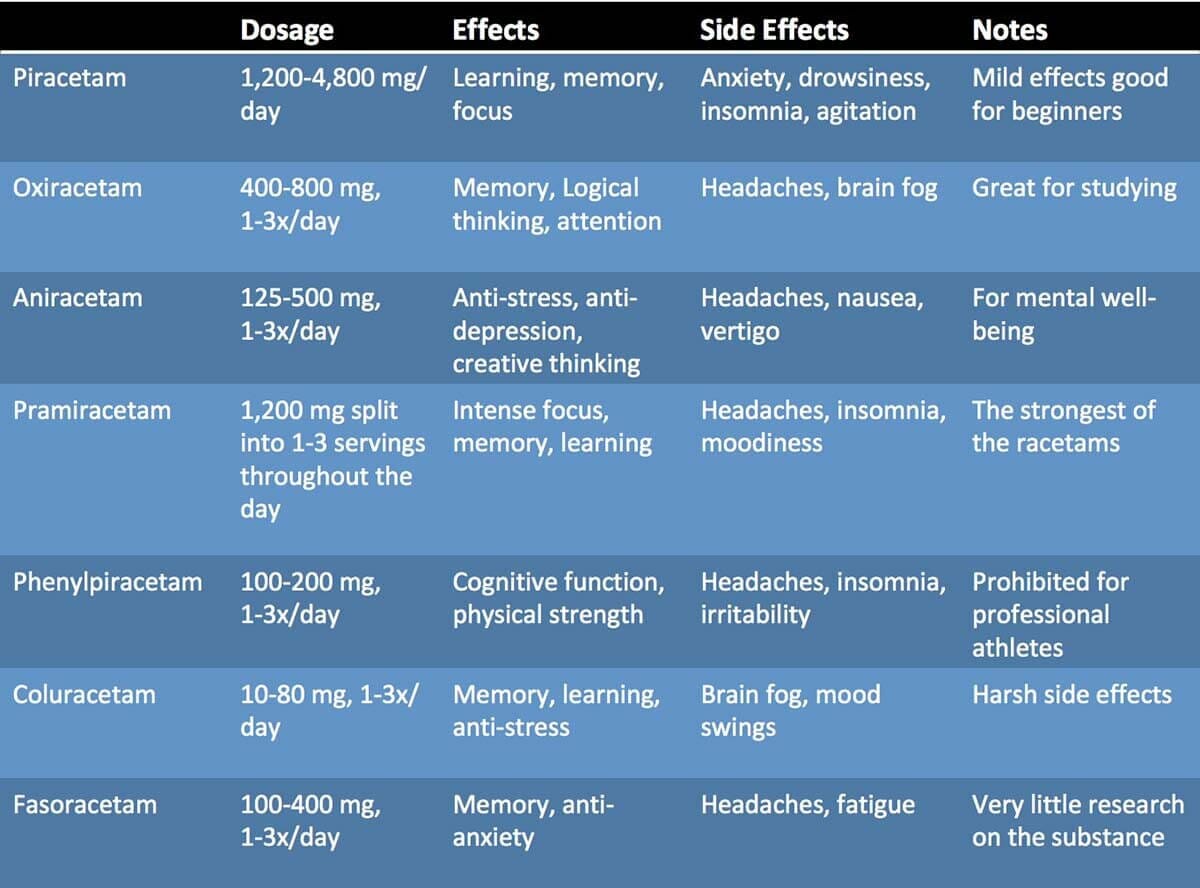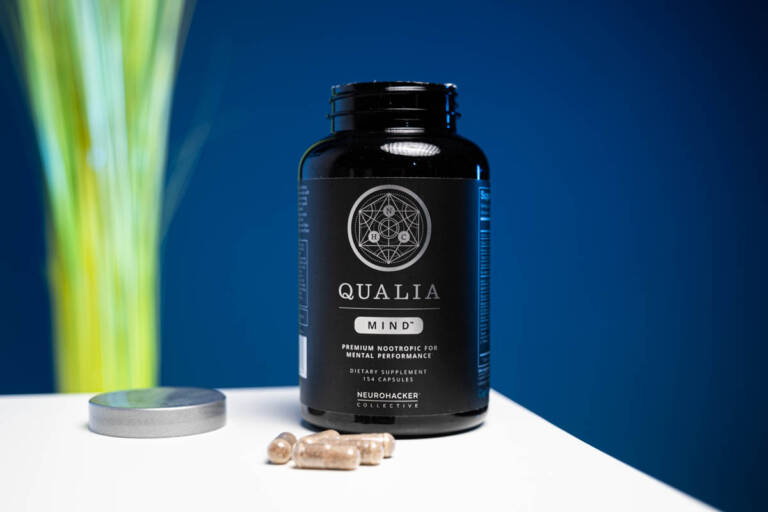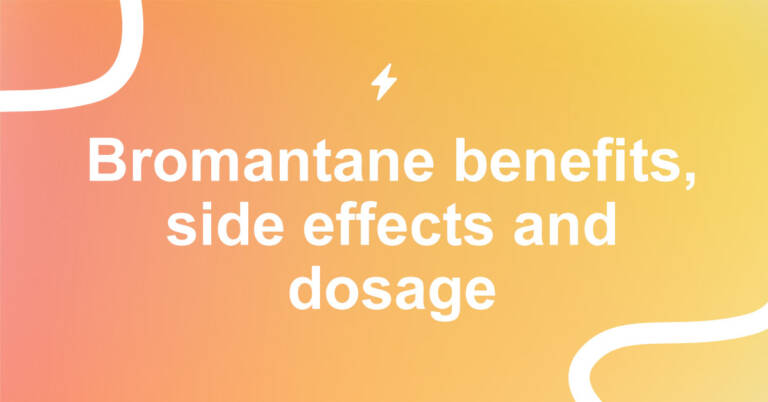Racetams are a class of drugs known for their nootropic effects. Actually, piracetam, one form of racetams, is the “original nootropic.” But what are the main benefits of racetams? Should you consider supplementing them? Check out our full racetams review.
What Are Racetams?
Racetams are a group of synthetic nootropics that have relatively similar structures and effects, but there is no “one size fits all” racetam.
These cognitive enhancers share the same basic chemical structure, but time, science and technology have enabled scientists to make tweaks to the base structure.
They ended up with quite a few new members of the racetam family that vary in function, strength, and dosage.
Racetams, in general, improve overall brain health, boost memory, help you with learning and focusing and offer good mood and anti-anxiety support.
Hopefully, we have your attention by now, and you must be asking yourself:
“What are the most popular racetams on the market, or better yet, which ones should I use?”
Look no further, because our extensive and in-depth list of racetams is just a few mouse wheel spins away!
Racetams List
Here is the list of racetams that currently exist:
- Piracetam
- Oxiracetam
- Aniracetam
- Pramiracetam
- Phenylpiracetam
- Coluracetam
- Fasoracetam
Let’s check them out in details.
Piracetam
Have you ever heard the name Corneliu E. Giurgea? This is the man who coined the term “nootropics” with the discovery of piracetam in 1964, making piracetam the oldest member of the racetam family.
It was first used and still serves best for treating cognitive decline in the elderly. It enhances cellular membrane fluidity and is great in giving you a slight edge in learning and memory retention (the effects of piracetam on learning are weak compared to other racetams). [1]
Additionally, piracetam helps to boost focus and sensory concentration.
Piracetam is water-soluble and does not need to be taken with food.
The standard recommended dose for adults is between 1,200-4,800 mg per day, but some individuals have only had notable effects in doses ranging around 10,000 mg.
It seems safe to use it regularly, as breaks are only necessary every 18 months of discontinued use. Because of its mild effects, piracetam also does not cause any pronounced side effects.
When taking this nootropic, you may experience very short-term anxiety, drowsiness, insomnia, or agitation, but nothing too serious.
Many scientific studies have been conducted with choline supplements alongside piracetam, as the two have been proven to have a synergistic relationship.
In a few animal models, choline has improved the cognitive effects of piracetam, but combining the two is more of a suggestion rather than a necessity. [2]
Oxiracetam
If you’re a student and are looking for “a study drug”, you’ve just hit a home run.
Oxiracetam, compared to piracetam, is proven to be far more potent than its older sibling even at smaller dosages. [2]
Oxiracetam is structurally different from piracetam due to a single hydroxyl group. In addition to working similarly to piracetam, it increases glutamate, acetylcholine, and D-aspartic acid release from neurons.
The release of these substances increases metabolic activity in the neurons, resulting in better memory formation.
Along with memory improvement, research shows it has the most promise in preventing neural decline and is very effective in improving attention, logical thinking, and overall memory.
The standard daily dosage tends to be 1,200-2,400 mg of oxiracetam split into two to three smaller doses throughout the day, preferably an hour before a learning activity.
What are the side effects of oxiracetam?
There are some reports of mild headaches, brain fog, restlessness, and nausea. Despite its mild stimulatory characteristics, oxiracetam will probably not interfere with your sleep.
This means you may take it in the evening, study for a few hours, and you’ll still be able to fall asleep, unlike with, say, drinking coffee late at night.
To avoid any nagging headaches, try stacking oxiracetam with a choline source, for example, Alpha GPC.
By adding choline, you assure you have enough acetylcholine in your neurons as oxiracetam burns through quite a lot of this neurotransmitter.
Aniracetam
If oxiracetam is the logical child, the third member of our family is the creative one. Aniracetam is 2-5 times more potent than piracetam, but its effects fade out after 2-4 hours. [3]
Aniracetam’s mechanism of action is surprisingly very well documented. It works primarily by targeting brain AMPA receptors and interacting with serotonin, dopamine, and choline.
These are all neurotransmitters that gauge our mental well-being, so it is to no-one’s surprise aniracetam has a great soothing effect on anxiety and stress. [4]
Additionally, it may boost the productivity of the right brain hemisphere, which is responsible for creative thinking.
Aniracetam seems best for spurring creativity, holistic thinking, and reducing stress and anxiety.
According to studies, even though aniracetam is fat-soluble, it does not need to be ingested with fatty acids and can be taken on an empty stomach.
The effective range of aniracetam seems between 400 mg and 1,500 mg per day, split into two or three serving.
Because aniracetam powder has a distinctly bitter taste, capsules may be a better solution for those who want to avoid the bitter taste in their mouth (no pun intended).
Due to its potent anxiolytic effect, some people may experience excessive relaxation when taking aniracetam and will feel less motivated to do any kind of mental work.
Other side effects may include nausea (it honestly tastes horrible), insomnia, vertigo, and headaches.
According to the opinion of some biohackers, it may be beneficial to combine oxiracetam, aniracetam and piracetam all together.
Combining the three compounds together goes hand in hand because of their effects and the pathways they take to get to the brain.
Piracetam may kick your brain into gear and boost your memory, oxiracetam may ramp up your logical thinking, and aniracetam may help you see the big picture of the project you’re working on.
Pramiracetam
Pramiracetam is another racetam that stems from the granddaddy piracetam.
Not to be mistaken for piracetam, it has not been as well researched as some of the other racetams on this list but is worth taking a look at nevertheless.
Animal and human studies conducted up until now have shown that pramiracetam has a profound effect on focus, improving learning ability, and enhancing long-term memory. [3]
It has been named “the strongest racetam” on the market.
By increasing high-affinity choline uptake and blood flow to the brain, pramiracetam may also make you zone in on the task at hand and reduce the “brain chatter” you might experience when you try to focus on mental activity.
The daily recommended intake for pramiracetam, when used as a cognitive enhancer, is at 1,200 mg, split into two to three servings divided throughout the day.
Pramiracetam does not come with a lot of unwanted luggage. It is relatively safe to use, as long as you take the recommended amount. [4]
Take more than 1,200 mg per day, and you may expose yourself to headaches, insomnia, moodiness, nausea, lethargy, and loss of appetite.
Phenylpiracetam
It is precisely what its name suggests: a piracetam with an added phenyl group. It is highly energizing and potent and has even been banned from the Olympics for being a performance-enhancing substance.
What makes phenylpiracetam so unique?
By adding the mentioned phenyl group to a piracetam, scientists have made the substance much more bioavailable and effective.
This is because it passes through the blood-brain barrier much more rapidly than piracetam itself.
While it is best known for improving brain function and physical strength, phenylpiracetam may also help with reducing symptoms of depression and anxiety. [4]
The optimal dose has not been proven yet, but phenylpiracetam seems most effective when taken acutely in the 100 mg-200 mg range for up to three times a day.
Side effects range from headaches and insomnia to irritability and heightened anger.
Here’s one last nugget: Phenylpiracetam may also help you with keeping your body weight in check, and even increase your tolerance to cold temperatures!
Well, the jury is still out on the latter, but some users have reported they don’t feel the cold as much as they used to.
Coluracetam
With coluracetam and the last remaining racetam, we are officially sailing into more and more uncharted waters.
Coluracetam is a synthetic compound that works similarly to pramiracetam by increasing choline levels via the HACU or the high-affinity choline uptake system.
Coluracetam can reboot this system even after nerve cell damage. [5]
It also has neuroprotective attributes, protecting the brain from strokes, Alzheimer’s disease, traumatic brain injury, and other brain diseases.
This synthetic nootropic may help you with improving memory and learning, treating depression, alleviating anxiety, and may even improve eyesight.
All of these claims, however, are relatively weak due to lack of adequate scientific research conducted on the substance.
The majority of the studies have been conducted with subjects taking anywhere from 10 mg to 80 mg taken up to three times per day. The upper boundary that is considered safe is thus at 240 mg per day.
Side effects usually show up when taking more than the daily recommended dose of 240 mg. The former include brain fog, depression, and irregular results based on the amount of sleep you have had.
Fasorecatem
Fasoracetam is a fairly new compound. It was first created in Japan in the 1990s but fell into oblivion after failing to pass phase 3 clinical exams, and the project was shut down. [6]
In 2013, another company relaunched the project and has now been conducting clinical trials on individuals with ADHD, autism, or anxiety since 2016. Fasoracetam is currently in phase 2 clinical exams. [7]
Like many other racetams, the mechanisms of action are not entirely transparent with fasoracetam.
It is believed that it increases the release of acetylcholine from the cerebral cortex, increases the number of GABA receptors, and activates metabotropic glutamate receptors
While heightened acetylcholine levels lead to improved memory formation, elevated GABA levels lead to depression and anxiety, and fasoracetam does a great job of keeping these levels in check.
Fasoracetam is commonly used 1 to 3 times a day in doses ranging from 100 mg-400 mg per serving.
The kidneys mainly remove the drug, so individuals with any kidney problems, stay away from it.
Side effects may include headaches, fatigue, and bradycardia (unusually lowered heart rate).
Racetams Compared
Here we prepared a comparison between different racetams, so it’s easier for you to understand the benefits, dosages, and side effects of particular racetams.
We suggest you carefully study this table to avoid any further issues.

Should you have any questions regarding this comparison, do let us know.
Where To Buy Racetams?
So, you’ve decided to try racetams and see how they work for you?
You can buy many racetams online, but due to the lack of research and a vague legal status of racetams, we currently recommend avoiding them all together.
Instead, we suggest you go for a high-quality nootropic supplement that provides pretty much the same effects, it is safer, and can be even more affordable.
Click on the button below to check our favorite nootropic supplements.
Frequently Asked Questions
Are Racetams safe to use? Are they addictive?
No, based on our research, none of the racetams have been proven to trigger addictive behavior in animals or humans. If you do decide to take any of the racetams for extended periods of time, you will be at risk of developing a tolerance to the chemicals, so cycling is recommended.
What should I stack my racetam with?
When looking for compounds to supplement your racetam use, experts often suggesting to combine any kind of racetam with a good choline source like Alpha GPC or Cognizin. In essence, the two compounds will have a synergistic effect on each other, which means the effect of one or the other will be slightly magnified.
Are racetams legal?
Yes, racetams are currently legal to buy. In the U.S., for example, the FDA has not approved any of the racetams as a drug or a supplement, yet the government has not exactly banned racetams either. They are not illegal, and there are no legal restrictions on possession and use.
How long do effects of the racetams last?
When talking about the longevity of a drug’s effects, the measuring stick usually used is the half-life of a drug. Half-life is the amount of time it takes for the amount or concentration of a drug to drop by one half. Now, let’s take a look at the half-lives of our racetams:
- Piracetam: approximately 5 hours
- Oxiracetam: approximately 8 hours
- Aniracetam: 2-4 hours
- Pramiracetam: 4.5-7.5 hours
- Phenylpiracetam: 3-5 hours
- Coluracetam: 3 hours
- Fasoracetam: approximately 2 hours
Keep in mind, this is the amount of time it takes the concentration of a racetam to drop by 50%. The real effects of the nootropic will usually be slightly more intense in the beginning, and will slowly fade over the mentioned periods of time.
To learn more about nootropics, check out our nootropic list here.
What is the best racetam?
Based on our opinion, the best racetam is piracetam. It is widely available, it provides multiple benefits, and it has been studied and used for many years.
What are racetams made of?
Racetams are made of a two-pyrrolidone nucleus, oxygen, nitrogen, and hydrogen. They are synthetic nootropics developed to enhance your cognitive abilities.







4 thoughts on “Racetams Guide: Benefits, Side Effects And More”
Love the article Greg Thank you and good job
Thanks a lot, Kevin, I appreciate it! :)
Great post!! Exactly what I needed, all the info presented in a single place in a language that even a baby can understand. The last piece of puzzle that I’m looking for is, where can I buy racetams on clearnet? Priority: should deliver the stuff I paid for and good quality control if possible.
Hi there, thanks for your feedback, we highly appreciate it! :) Check Purenootropics, it’s a store that we have great experiences with :)